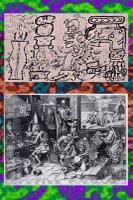
It is generally agreed that the outside panels of
The Garden of Delights/El Jardín de las Delicias are based on the frontispiece of the
Nuremberg Chronicle, but there are several differences.

One is that the orb is divided in half, and contains what looks like a picture of an island. It appears to be about the size of São Tomé, off the coast of Africa, which was once thought to be round and to be bisected by the Equator. Mercator and Hondius maps continued to resemble the outside panels of
The Garden of Delights/El Jardín de las Delicias in the seventeenth century. The divided orb can also be interpreted as an illustration of the division of the earth in two parts by the Treaty of Tordesillas.

Another difference is that instead of God on a throne, holding an orb, the outside panels show a king on a bench, holding a book, presumably King David as the author of the book of Psalms (although not necessarily:
see above). Also, instead of illustrating a tabernacle like the ones that were built after the crossing of the sea on dry land, represented in the book illustration by some small angels tying branches together, the whole image divides in half, as if a picture of the ocean were opened up like a door.


















